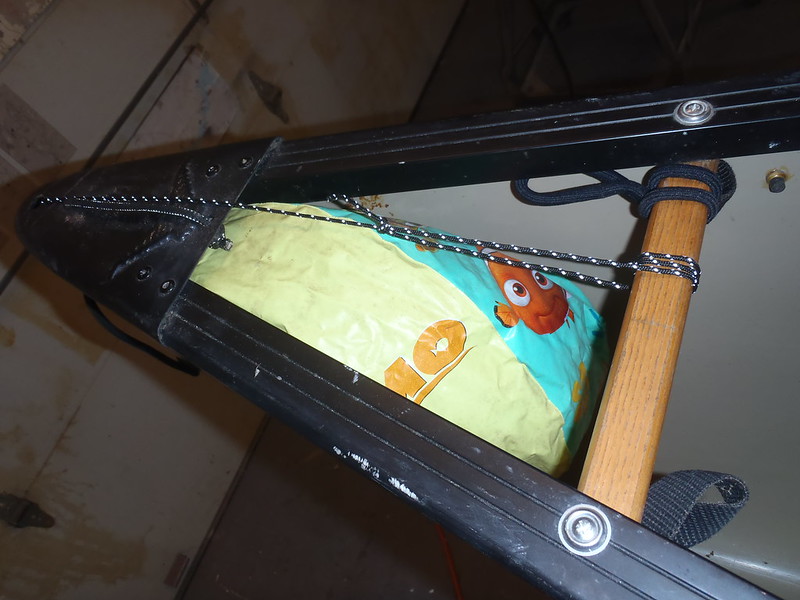G
Guest
Guest
BWCA’s “Gunwales and decks” thread got me thinking about wood gunwales and decks. Not just some water shedding slope on the inwale vs adding scallops, and making weep holes in the deck plate tips, but especially about the gunk that gets trapped near those weep holes as the water drains out.
A lot of my day paddling is small woody streams and swamps. With some wet foot entry there is often a lot of leaf litter, mud, dead bugs and twiggy debris in the bilge, some of which when I flip the canoe over accumulates at that drain hole tip. It doesn’t all fall out, especially after it has had the chance to compact and dry out.
I’d like to say that I hose out the canoe after every trip, but probably more like 50% of the time. When I do a considerable amount of, well, “wet compost” flushes out when I blast a hose at the stems. Disgusting stuff that sometimes necessitates grubbing around up there with fingers.
dang hard to see what is left up there and I sometimes take a bottle brush to the stem interiors. Even then I am probably leaving a caked film of wet dirt at the deck plate tips.
That gunk is not a rot issue with vinyl deck plates, but damp decaying stuff laying on the underside of a wood deck plate seems like an invitation for bacterial rot.
Questions for folks who build wood deck plates. Do you epoxy and varnish the deck plates or otherwise uber-seal them against bacterial rot with some product? Or somehow shape the undersides for better gunk accumulation avoidance.
Maybe most wood deck plate folks more anal than I about thoroughly hosing out the canoe after every trip.
For all the “Care and feeding” information manufacturers provide I don’t recall seeing any manufacturer stress a thorough hose out for wood deck plate/inwale longevity. I do take the big dog-bone sponge and scoop out the worst of the debris laden bilge water before getting under the yoke. I do not come close to getting it all; mostly I don’t want a bird’s nest of twigs and mud falling on my head
Not just deck plates. That same bilge dirt/mud/debris does the inwales no favors, and is even worse for the butt ends of thwarts and yoke, where a Petri-dish of impacted dirt will start growing bacteria in that interstitial gap. Think older used canoes with rot blackened yoke and thwart ends.
I seem to recall that someone (Alan Gage?) adds a flared projection off the inwales to eliminate that gap.
How do you make/shape deck plates and inwales, and how do you keep them clean?
A lot of my day paddling is small woody streams and swamps. With some wet foot entry there is often a lot of leaf litter, mud, dead bugs and twiggy debris in the bilge, some of which when I flip the canoe over accumulates at that drain hole tip. It doesn’t all fall out, especially after it has had the chance to compact and dry out.
I’d like to say that I hose out the canoe after every trip, but probably more like 50% of the time. When I do a considerable amount of, well, “wet compost” flushes out when I blast a hose at the stems. Disgusting stuff that sometimes necessitates grubbing around up there with fingers.
dang hard to see what is left up there and I sometimes take a bottle brush to the stem interiors. Even then I am probably leaving a caked film of wet dirt at the deck plate tips.
That gunk is not a rot issue with vinyl deck plates, but damp decaying stuff laying on the underside of a wood deck plate seems like an invitation for bacterial rot.
Questions for folks who build wood deck plates. Do you epoxy and varnish the deck plates or otherwise uber-seal them against bacterial rot with some product? Or somehow shape the undersides for better gunk accumulation avoidance.
Maybe most wood deck plate folks more anal than I about thoroughly hosing out the canoe after every trip.
For all the “Care and feeding” information manufacturers provide I don’t recall seeing any manufacturer stress a thorough hose out for wood deck plate/inwale longevity. I do take the big dog-bone sponge and scoop out the worst of the debris laden bilge water before getting under the yoke. I do not come close to getting it all; mostly I don’t want a bird’s nest of twigs and mud falling on my head
Not just deck plates. That same bilge dirt/mud/debris does the inwales no favors, and is even worse for the butt ends of thwarts and yoke, where a Petri-dish of impacted dirt will start growing bacteria in that interstitial gap. Think older used canoes with rot blackened yoke and thwart ends.
I seem to recall that someone (Alan Gage?) adds a flared projection off the inwales to eliminate that gap.
How do you make/shape deck plates and inwales, and how do you keep them clean?



